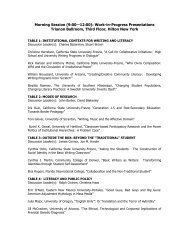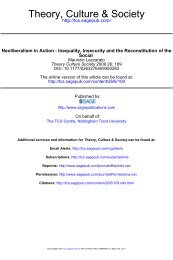Tacit Knowing: Its Bearing on Some Problems of Philosophy
Tacit Knowing: Its Bearing on Some Problems of Philosophy
Tacit Knowing: Its Bearing on Some Problems of Philosophy
Create successful ePaper yourself
Turn your PDF publications into a flip-book with our unique Google optimized e-Paper software.
Michael Polanyi http://faculty.uml.edu/rinnis/45.301%20Ways%20<strong>of</strong>%20Knowi...<br />
This view <strong>of</strong> the localizati<strong>on</strong> <strong>of</strong> sights seen does not tell<br />
us how such sights, or any other states <strong>of</strong> c<strong>on</strong>sciousness, arise<br />
from (or in c<strong>on</strong>juncti<strong>on</strong> with) neural processes. This problem is<br />
set aside in this paper. We <strong>on</strong>ly assume that whenever we have<br />
c<strong>on</strong>scious experiences, we also have the power <strong>of</strong> integrating<br />
them meaningfully. It is by this power then that we see things as<br />
we do, and the fact that the physiologist does not see these things<br />
when observing the visual processes in the cortex, can be ascribed<br />
to the fact that he attends to these neural processes in themselves.<br />
The rest <strong>of</strong> this paper will serve mainly to c<strong>on</strong>solidate and<br />
elaborate this c<strong>on</strong>clusi<strong>on</strong>.<br />
It is interesting to compare, with this in mind, the process<br />
<strong>of</strong> integrati<strong>on</strong> by which we arrive at tacit knowing, with a formal<br />
process <strong>of</strong> inference by which we might arrive at the same<br />
c<strong>on</strong>clusi<strong>on</strong>. Optical illusi<strong>on</strong>s <strong>of</strong>fer a good example for such an<br />
enquiry. In a famous experiment <strong>of</strong> Ames we are facing the wall<br />
<strong>of</strong> a room in which we see <strong>on</strong>e corner occupied by a. small boy<br />
and the opposite corner by a grown man. An illusi<strong>on</strong> makes us<br />
see the boy as taller than the man. This is due to the skew shape<br />
<strong>of</strong> the room, which we had not noticed. In this room, the distance<br />
between ceiling and floor is much less at the other corner where<br />
the man is placed. At the same time the boy’s corner is nearer to<br />
us than the man’s. Helmholtz (1866) has described percepti<strong>on</strong>,<br />
including optical illusi<strong>on</strong>s, as the result <strong>of</strong> unc<strong>on</strong>scious reas<strong>on</strong>ing.<br />
In this case the premise <strong>of</strong> such reas<strong>on</strong>ing would be, that rooms<br />
are right-angled parallelepipeds in which (1) the distance between<br />
ceiling and floor is everywhere the same and (2) from a point<br />
facing the-middle <strong>of</strong> a wall the two corners <strong>of</strong> the wall are<br />
equidistant. Hence a boy whose head touches the ceiling is taller<br />
than a man whose head leaves a gap <strong>of</strong> a foot or so under the<br />
ceiling; the more so, if the angle <strong>of</strong> visi<strong>on</strong> enclosing the boy, from<br />
head to foot, is corresp<strong>on</strong>dingly larger than the angle under which<br />
the man is seen. To be more precise, we would have to introduce<br />
an intermediate state <strong>of</strong> reas<strong>on</strong>ing which causes us to see the skew<br />
shaped room as if it were normal. The experiment is arranged in<br />
such a manner that from the point from which we view the room,<br />
the angles <strong>of</strong> visi<strong>on</strong> by which we see its corners are the same as<br />
they would be for a normal room. This fact is taken to c<strong>on</strong>firm<br />
with respect to the room in<br />
11. This is not to accept the distincti<strong>on</strong> <strong>of</strong> two kinds <strong>of</strong> experience, <strong>on</strong>e<br />
from inside, the other from outside. The physiologist’s view <strong>of</strong> organs<br />
and their functi<strong>on</strong>s is an internal comprehensi<strong>on</strong> <strong>of</strong> a living being,<br />
compared with a purely physical and chemical topography <strong>of</strong> a living<br />
body which would c<strong>on</strong>tain no such understanding. I am envisaging a<br />
c<strong>on</strong>tinuous range in degrees <strong>of</strong> indwelling; not two aspects, <strong>on</strong>e from<br />
inside, the other from outside.<br />
607<br />
fr<strong>on</strong>t <strong>of</strong> us, our major premise, that all rooms are right-angled<br />
parallelepipeds.<br />
12 <strong>of</strong> 27 1/26/10 9:36 AM





